基于SpringBoot实现一个可扩展的事件总线
前言
在日常开发中,我们经常会用到事件总线,SpringBoot通过事件多播器的形式为我们提供了一个事件总线,但是在开发中我们经常会用到其他的实现,比如Guava、Disruptor的。我们将基于SpringBoot封装一套底层驱动可扩展的,统一api的事件驱动组件。
环境准备
jdk1.8
spring-boot-autoconfigure
Guava
Disruptor
pom文件如下
<?xml version="1.0" encoding="UTF-8"?>
<project xmlns="http://maven.apache.org/POM/4.0.0" xmlns:xsi="http://www.w3.org/2001/XMLSchema-instance"
xsi:schemaLocation="http://maven.apache.org/POM/4.0.0 https://maven.apache.org/xsd/maven-4.0.0.xsd">
<modelVersion>4.0.0</modelVersion>
<parent>
<groupId>org.springframework.boot</groupId>
<artifactId>spring-boot-starter-parent</artifactId>
<version>2.7.5</version>
<relativePath/> <!-- lookup parent from repository -->
</parent>
<groupId>com.billetsdoux</groupId>
<artifactId>eventBus</artifactId>
<version>1.0.0</version>
<name>eventBus</name>
<description>eventBus</description>
<properties>
<java.version>1.8</java.version>
</properties>
<dependencies>
<dependency>
<groupId>org.springframework.boot</groupId>
<artifactId>spring-boot-starter</artifactId>
</dependency>
<dependency>
<groupId>com.google.guava</groupId>
<artifactId>guava</artifactId>
<version>31.1-jre</version>
</dependency>
<dependency>
<groupId>cn.hutool</groupId>
<artifactId>hutool-all</artifactId>
<scope>compile</scope>
<version>5.8.9</version>
</dependency>
<dependency>
<groupId>com.lmax</groupId>
<artifactId>disruptor</artifactId>
<version>3.4.4</version>
</dependency>
<dependency>
<groupId>org.projectlombok</groupId>
<artifactId>lombok</artifactId>
</dependency>
<dependency>
<groupId>org.springframework.boot</groupId>
<artifactId>spring-boot-autoconfigure</artifactId>
</dependency>
</dependencies>
</project>
组件介绍
整体架构#
目录结构如下:
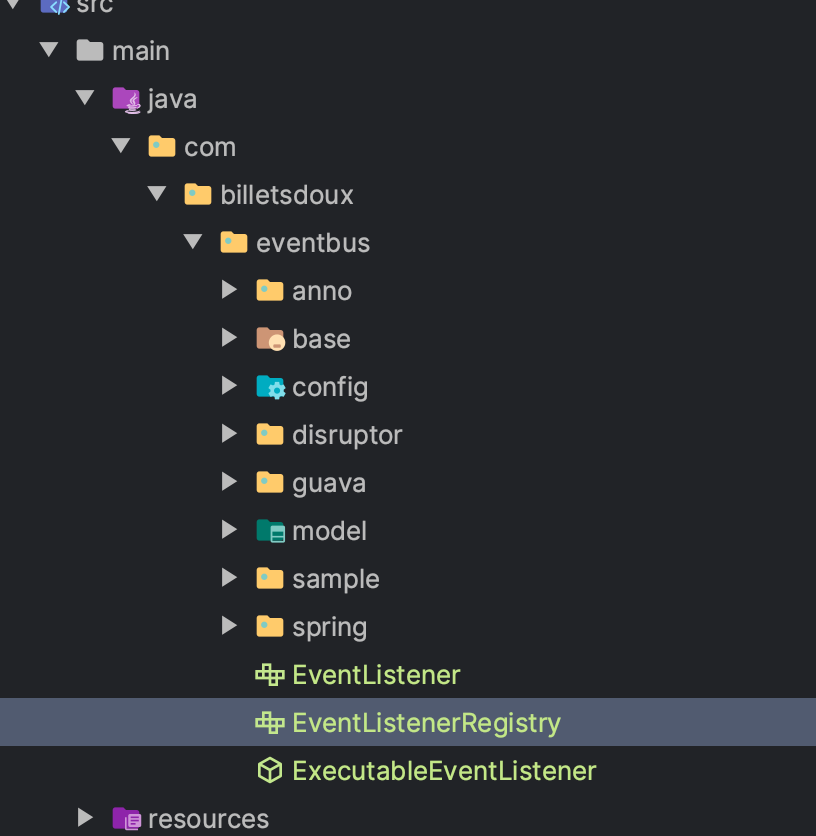
我们的核心是一个EventListenerRegistry,它便是我们提供统一api的入口,它有两个方法,一个是init方法,在SpringBoot容器启动的时候会去注册我们所有的事件监听器,publish 方法则为事件发布的方法。这里我为它提供了3种实现,Guava,Spring,Disruptor

EventModel#
这是我们定义的事件模型,topic为事件主题,我们通过不同的topic对应不同的事件处理器,entity为具体的事件对象模型
package com.billetsdoux.eventbus.model;
import lombok.Data;
import lombok.NoArgsConstructor;
import java.io.Serializable;
@Data
@NoArgsConstructor
public class EventModel<T> implements Serializable {
/**
* 事件发布主题
*/
private String topic;
/**
* 事件对象模型
*/
private T entity;
}
EventListener#
EventListener 为事件消费接口,定义了2个方法,topic() 为监听的事件topic,onMessage()为事件的回调接口。
package com.billetsdoux.eventbus;
/**
* 消费接口
*/
public interface EventListener<T> {
String topic();
void onMessage(T message);
}
EventListenerRegistry#
这边是我们之前介绍的事件核心接口,它提供两个接口 initRegistryEventListener 负责注册我们所定义的所有事件监听器,publish 负责发送消息,我们底层的驱动需要继承这个接口。
public interface EventListenerRegistry<P> {
void initRegistryEventListener(List<EventListener> eventConsumerList);
void publish(P param);
}
SpringEventListenerRegistry#
这是我们通过Spring为我们提供的消息多播器来实现的一个事件驱动。这个类被@Component标记,那么它会在容器启动的时候,通过构造器为我们注入 eventListeners ,applicationContext 。eventListeners 为所有实现了EventListener接口,并被注入到容器里面的类。
initRegistryEventListener 这是一个空方法,因为他们本身已经在容器中了,所以不需要注册了
publish: 直接调用applicationContext.publishEvent就可以了。
package com.billetsdoux.eventbus.spring;
import com.billetsdoux.eventbus.EventListener;
import com.billetsdoux.eventbus.EventListenerRegistry;
import com.billetsdoux.eventbus.model.EventModel;
import lombok.RequiredArgsConstructor;
import lombok.extern.slf4j.Slf4j;
import org.springframework.context.ApplicationContext;
import org.springframework.stereotype.Component;
import javax.annotation.PostConstruct;
import java.util.List;
@RequiredArgsConstructor
@Slf4j
@Component
public class SpringEventListenerRegistry implements EventListenerRegistry<EventModel> {
final ApplicationContext applicationContext;
final List<EventListener> eventListeners;
@Override
public void initRegistryEventListener(List<EventListener> eventConsumerList) {
}
@Override
public void publish(EventModel param) {
applicationContext.publishEvent(param);
}
@PostConstruct
public void init(){
log.info("开始初始化Spring事件监听器的组件服务");
initRegistryEventListener(eventListeners);
log.info("完成初始化Spring事件监听器的组件服务");
}
}
GuavaEventListenerRegistry#
基于Guava来实现的事件总线,我们首先还是需要容器帮我们注入eventListeners。相较于Spring我们需要自己定义一个Guava的EventBus,然后把我们的Listener注册到这个EventBus中。
publish方法则是调用EventBus的post方法到。
package com.billetsdoux.eventbus.guava;
import cn.hutool.core.thread.ThreadUtil;
import com.billetsdoux.eventbus.EventListener;
import com.billetsdoux.eventbus.EventListenerRegistry;
import com.billetsdoux.eventbus.model.EventModel;
import com.google.common.eventbus.AsyncEventBus;
import com.google.common.eventbus.EventBus;
import lombok.extern.slf4j.Slf4j;
import org.springframework.objenesis.instantiator.util.ClassUtils;
import org.springframework.stereotype.Component;
import javax.annotation.PostConstruct;
import java.util.List;
import java.util.concurrent.ExecutorService;
@Component("guava")
@Slf4j
public class GuavaEventListenerRegistry implements EventListenerRegistry<EventModel> {
EventBus eventBus;
final List<EventListener> eventListeners;
public GuavaEventListenerRegistry(List<EventListener> eventListeners) {
this.eventListeners = eventListeners;
}
@Override
public void initRegistryEventListener(List<EventListener> eventConsumerList) {
final ExecutorService executor = ThreadUtil.newExecutor(10, 20, 300);
eventBus = new AsyncEventBus(GuavaEventListenerRegistry.class.getName(),executor);
eventConsumerList.forEach(param->{
log.info("注册监听器:{}",param.getClass().getName());
eventBus.register(ClassUtils.newInstance(param.getClass()));
});
}
@Override
public void publish(EventModel param) {
eventBus.post(param);
}
@PostConstruct
public void init(){
log.info("开始初始化Guava事件监听器的组件服务");
initRegistryEventListener(eventListeners);
log.info("完成初始化Guava事件监听器的组件服务");
}
}
DisruptorEventListenerRegistry#
Disruptor的实现相对来说麻烦一点,它首先需要一个实现了EventFactory接口的类,它提供一个newInstance接口来创建事件对象模型。
具体的使用方式可以参考我这篇博文:Disruptor入门
EventModelFactory
我们首先还是需要注入我们的Listener,只是这里在init的时候是将我们的Listener交给我们的Disruptor去处理,我们先将Listener转成EventHandler,所以我们的监听器接口具体实现的时候除了实现我们定义的EventListener接口外还需要继承Disruptor的EventHandler接口。 调用disruptor.handleEventsWith(dataListener); 把我们的Listener交给Disruptor去管理。最后再启动Disruptor。
publish:调用Disruptor的RingBuffer来进行消息的发送。
/**
* 事件工厂
* Disruptor 通过EventFactory在RingBuffer中预创建Event的实例
* @param <T>
*/
public class EventModelFactory<T> implements EventFactory<EventModel<T>> {
@Override
public EventModel<T> newInstance() {
return new EventModel<>();
}
}
@Slf4j
@RequiredArgsConstructor
@Component("disruptor")
@Scope("prototype") // 线程安全问题
public class DisruptorEventListenerRegistry implements EventListenerRegistry<EventModel>,AutoCloseable {
/**
* disruptor事件处理器
*/
@Getter
@Setter
private Disruptor<EventModel> disruptor;
@NonNull
final List<EventListener> eventListeners;
/**
* RingBuffer的大小
*/
private final int DEFAULT_RING_SIZE = 1024 * 1024;
/**
* 事件工厂
*/
private EventFactory<EventModel> eventFactory = new EventModelFactory();
@Override
public void initRegistryEventListener(List<EventListener> eventConsumerList) {
disruptor = new Disruptor<>(eventFactory, DEFAULT_RING_SIZE, createThreadFactory(), ProducerType.SINGLE, new BlockingWaitStrategy());
EventHandler[] dataListener = eventConsumerList.stream().map(param -> {
EventListener<EventModel> eventModelEventListener = param;
return eventModelEventListener;
}).collect(Collectors.toList()).toArray(new EventHandler[eventConsumerList.size()]);
log.info("注册服务信息接口:{}",dataListener);
disruptor.handleEventsWith(dataListener);
disruptor.start();
}
@Override
public void publish(EventModel param) {
publishEvent(param);
}
public void publishEvent(EventModel... eventModels){
Objects.requireNonNull(disruptor, "当前disruptor核心控制器不可以为null");
Objects.requireNonNull(eventModels, "当前eventModels事件控制器不可以为null");
// 发布事件
final RingBuffer<EventModel> ringBuffer = disruptor.getRingBuffer();
try {
final List<EventModel> dataList = Arrays.stream(eventModels).collect(Collectors.toList());
for (EventModel element : dataList) {
// 请求下一个序号
long sequence = ringBuffer.next();
// 获取该序号对应的事件对象
EventModel event = ringBuffer.get(sequence);
event.setTopic(element.getTopic());
event.setEntity(element.getEntity());
ringBuffer.publish(sequence);
}
}catch (Exception e) {
log.error("error",e);
}
}
/**
* 关闭处理机制
* @throws Exception
*/
@Override
public void close() throws Exception {
if (Objects.nonNull(disruptor)) disruptor.shutdown();
}
@PostConstruct
public void init(){
log.info("开始初始化Disruptor事件监听器的组件服务");
initRegistryEventListener(eventListeners);
log.info("完成初始化Disruptor事件监听器的组件服务");
}
private static ThreadFactory createThreadFactory(){
AtomicInteger integer = new AtomicInteger();
return r-> new Thread(r,"disruptor-"+integer.incrementAndGet());
}
}
至此我们已经实现了我们的目标三个EventListenerRegistry,我们接下来看看我们Listener如何实现。
BaseEventListener#
我们刚说过我们的Listener需要同时实现EventHandler跟EventListener,所以我们定义一个抽象类,注意这个EventListener是我们定义的,EventHandler是Disruptor定义的。
public abstract class BaseEventListener<T> implements EventListener<T>, EventHandler<T> {
}
ExecutableEventListener#
我们定义一个抽象类ExecutableEventListener 我们来实现一下里面的方法。
对于Spring跟Guava来说只需要在方法上添加注解便可以在事件发生的时候回调过来,而对于Disruptor来说它的回调是继承EventHandler里面的onEvent方法。所以我们在onEvent里面手动调用onMessage方法,让所有的消息都转发给onMessage处理。
@org.springframework.context.event.EventListener Spring的回调注解
@Subscribe 的回调注解
onMessage:我们先调用topic()方法获取Listener方法的topic,这个方法我们这里先不实现,交给具体的实现类去实现这个方法。我们再定义一个handle的抽象方法,则是我们具体的消息处理逻辑的方法,也交给具体的实现类去实现。
@Slf4j
public abstract class ExecutableEventListener extends BaseEventListener<EventModel<?>> {
@org.springframework.context.event.EventListener
@Subscribe
@Override
public void onMessage(EventModel<?> message) {
log.info("收到消息:{}",message);
if (topic().equals(message.getTopic())){
handle(message);
}
}
@Override
public void onEvent(EventModel<?> event, long sequence, boolean endOfBatch) throws Exception {
onMessage(event);
}
/**
* 具体消息处理方法
* @param message
*/
protected abstract void handle(EventModel<?> message);
}
至此我们的核心代码就开发完成了,现在定义两个注解,让我们能够在项目中启用它。
EnableEventBus:在启动类上添加这个注解以启用EventBus
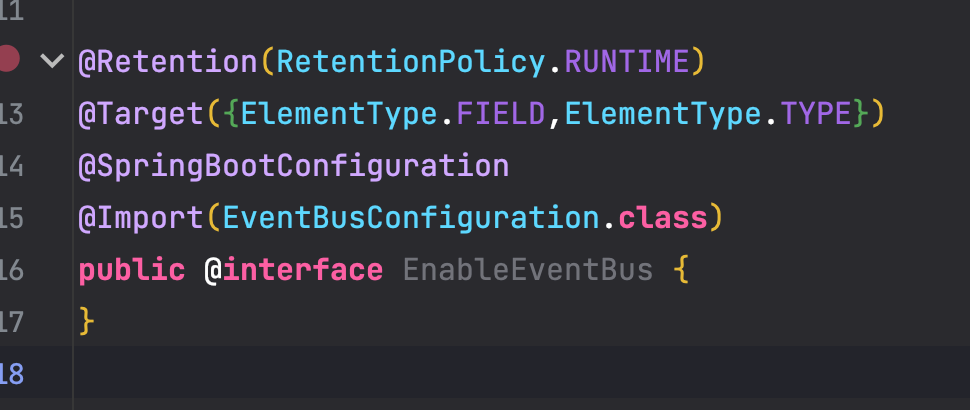
EventBusConfiguration:配置一下Spring的包扫描路径

测试
我们把我们刚写的项目install到本地maven仓库,以便我们在项目中能够引用它。我们新建一个SpringBootWeb项目添加这个依赖测试下
在pom中添加
<dependency>
<groupId>com.billetsdoux</groupId>
<artifactId>eventBus</artifactId>
<version>1.0.0</version>
</dependency>
<dependency>
<groupId>org.springframework.boot</groupId>
<artifactId>spring-boot-starter-web</artifactId>
</dependency>
在启动类上添加这个注解启用
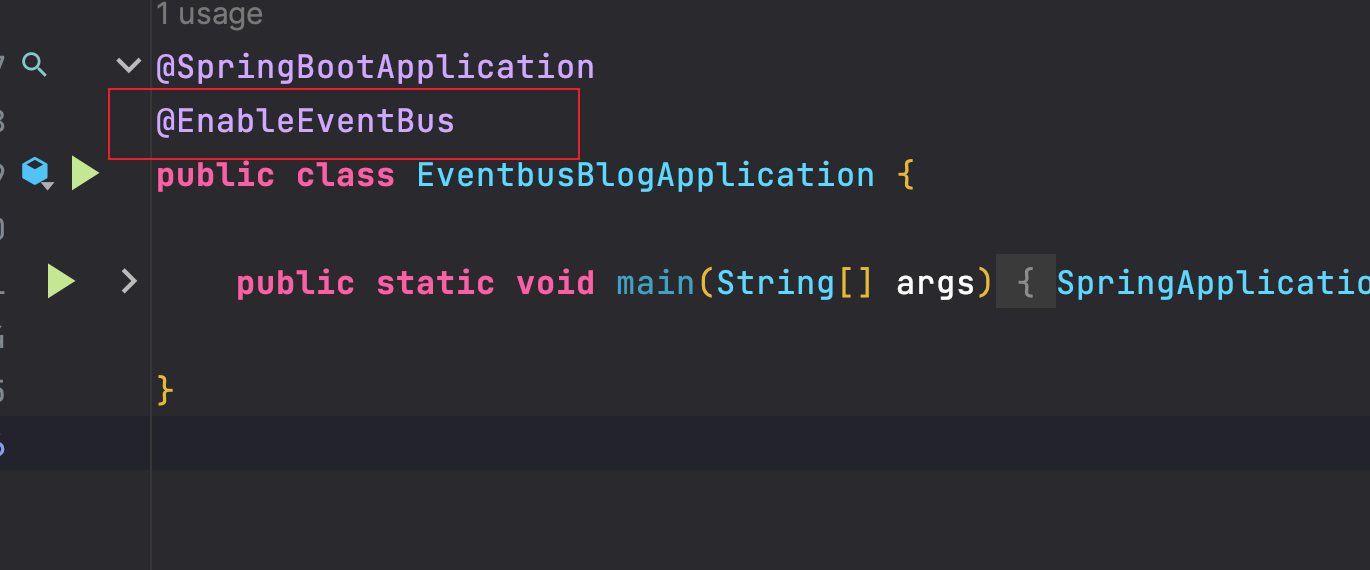
添加一个事件监听器,继承ExecutableEventListener,监听”blog“消息的主题。
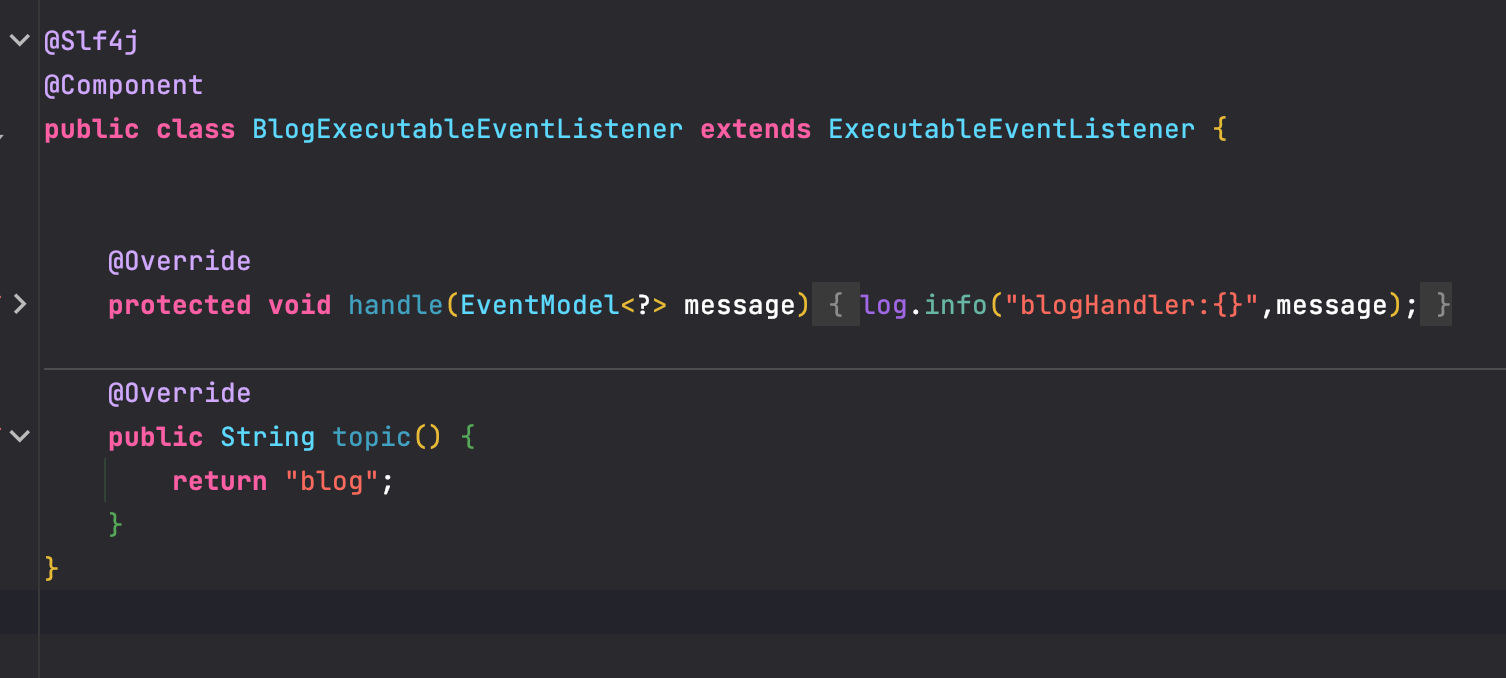
添加一个Controller来测试一下我们的事件总线。它根据我们的type来选择不同的底层驱动:spring,guava,disruptor
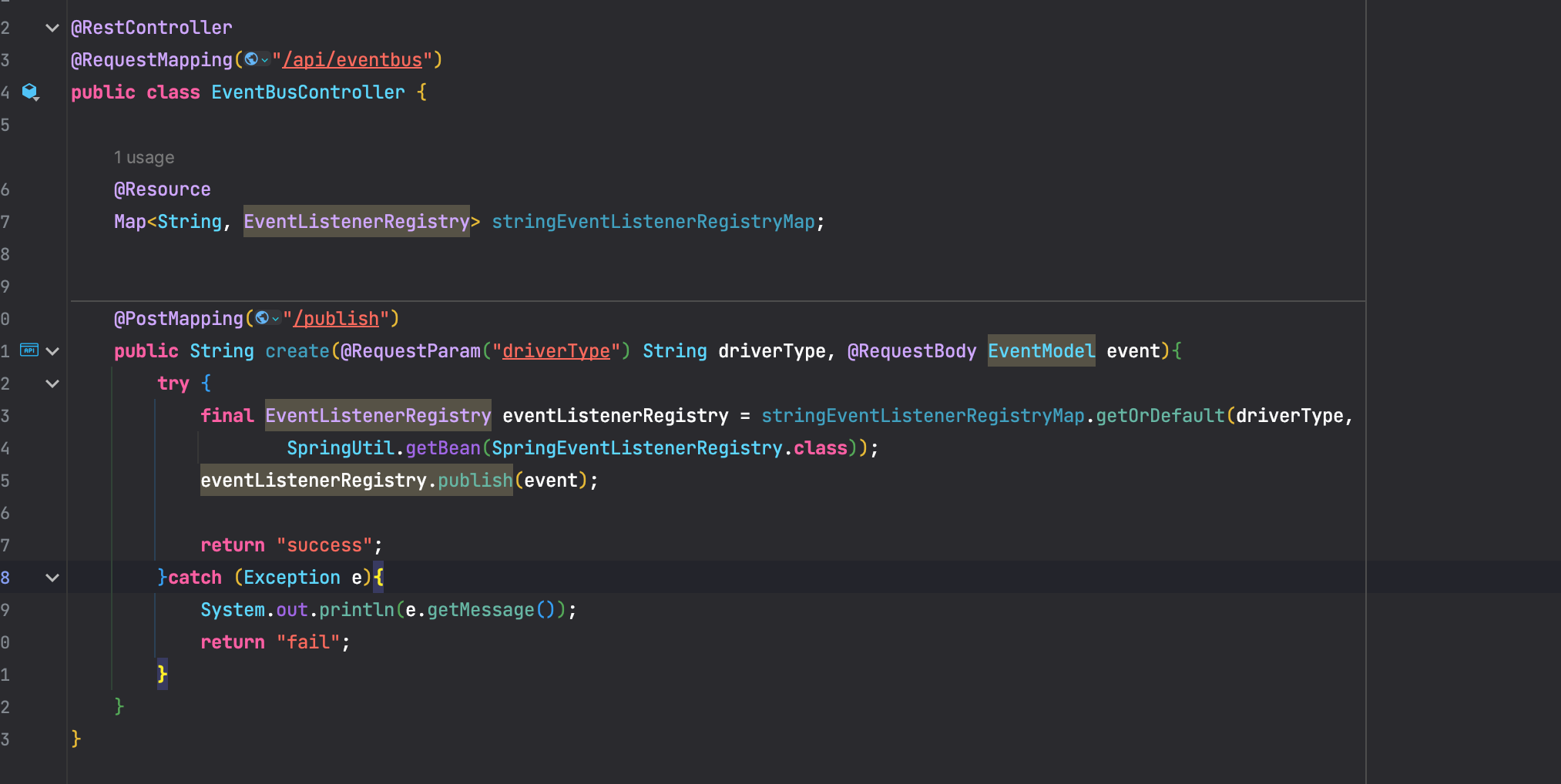
我们打包成docker镜像然后启动。
Dockerfile如下:
FROM openjdk:8-jre-slim
MAINTAINER billtsdoux
WORKDIR /app
ADD target/eventbus_blog*.jar app.jar
EXPOSE 8080
ENV JVM_OPTS="-Xmx256m -Xms256m" \
TZ=Asia/Shanghai
RUN ln -sf /usr/share/zoneinfo/$TZ /etc/localtime \
&& echo $TZ > /etc/timezone
ENTRYPOINT ["sh","-c","java -jar $JVM_OPTS app.jar"]
我们这里配置一下打包后镜像的名称,已经启动的容器名称跟监听的端口。
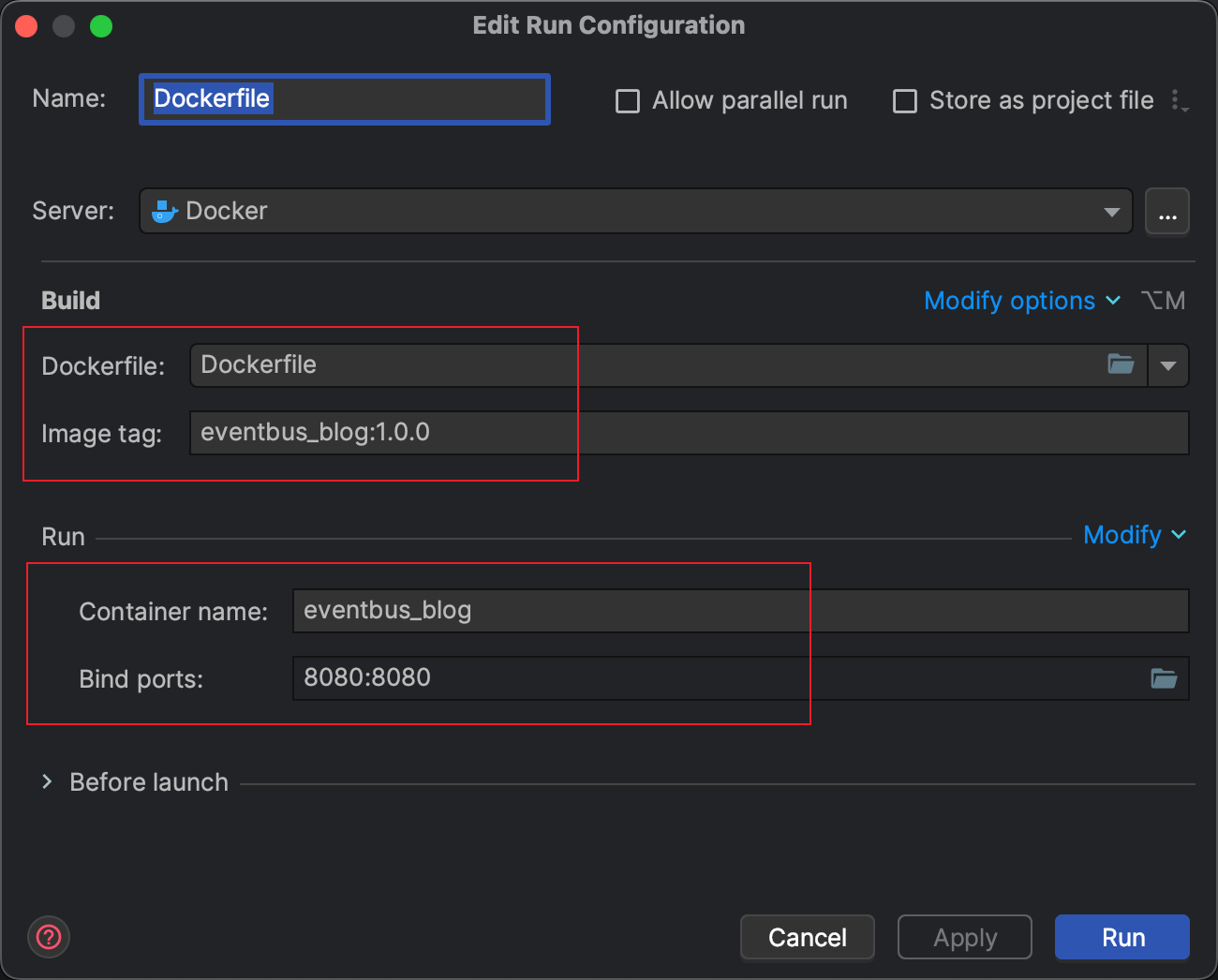
构建成功
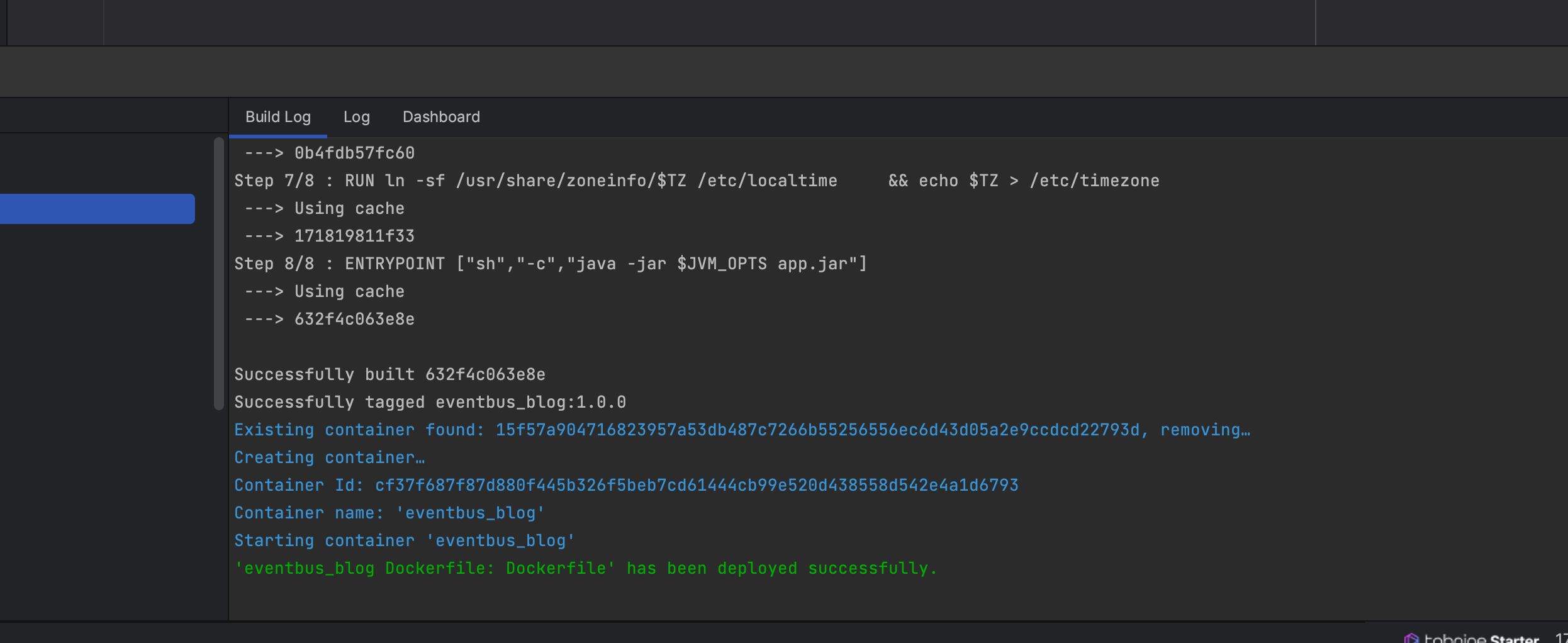
并且也启动一个容器:

查看日志可以看到我们内置的三个监听器注册器已经成功启动了。
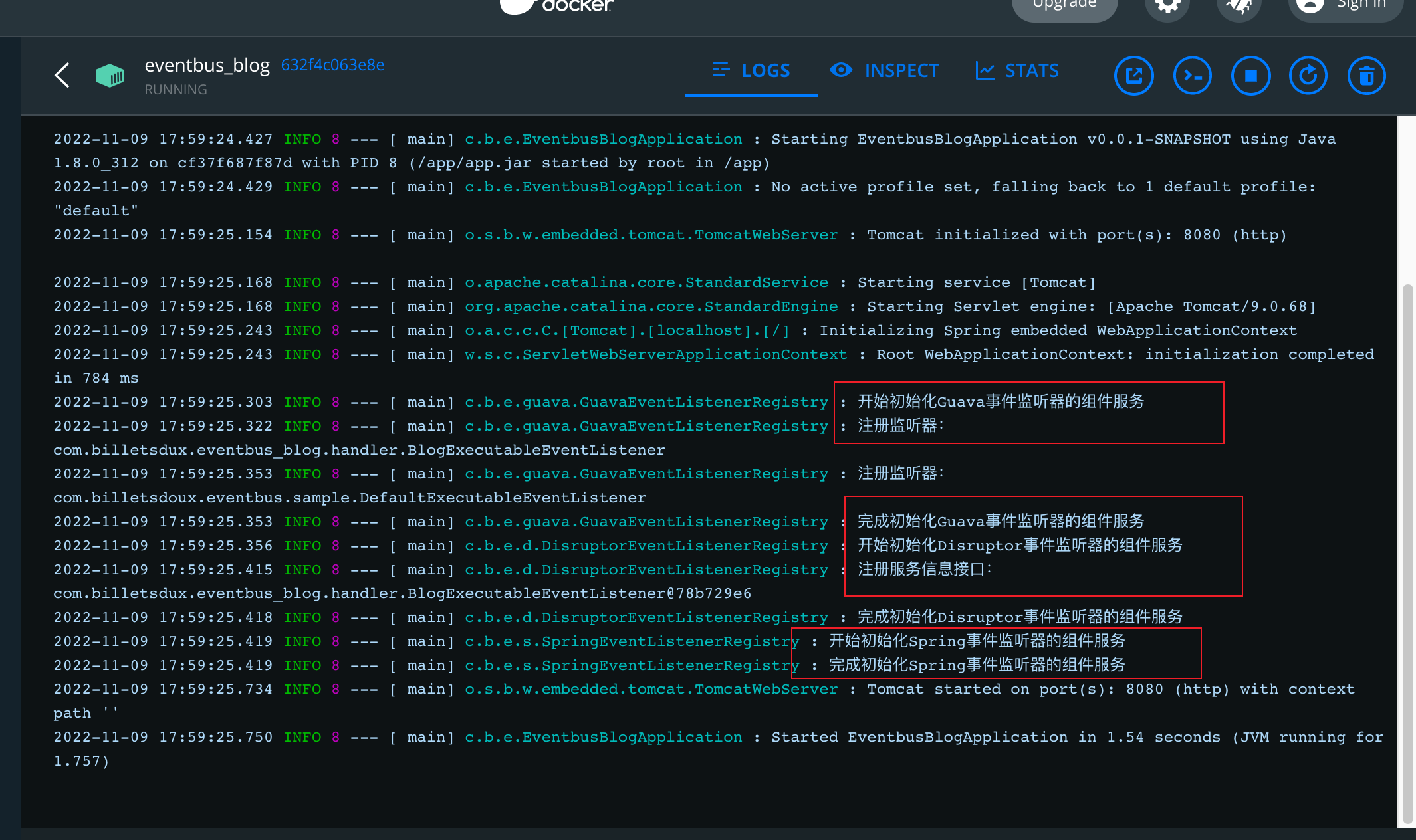
我们测试一下接口:可以看到根据我们选择的不同类型我们可以选择不同的实现。



后言
如果提供这个三个不够用,我们还可以通过实现这个接口EventListenerRegistry来扩展我们的事件总线组件,再注入到容器中,在调用的时候选择具体的实现就好了。





【推荐】编程新体验,更懂你的AI,立即体验豆包MarsCode编程助手
【推荐】凌霞软件回馈社区,博客园 & 1Panel & Halo 联合会员上线
【推荐】抖音旗下AI助手豆包,你的智能百科全书,全免费不限次数
【推荐】博客园社区专享云产品让利特惠,阿里云新客6.5折上折
【推荐】轻量又高性能的 SSH 工具 IShell:AI 加持,快人一步
· DeepSeek “源神”启动!「GitHub 热点速览」
· 我与微信审核的“相爱相杀”看个人小程序副业
· 上周热点回顾(2.17-2.23)
· 如何使用 Uni-app 实现视频聊天(源码,支持安卓、iOS)
· C# 集成 DeepSeek 模型实现 AI 私有化(本地部署与 API 调用教程)